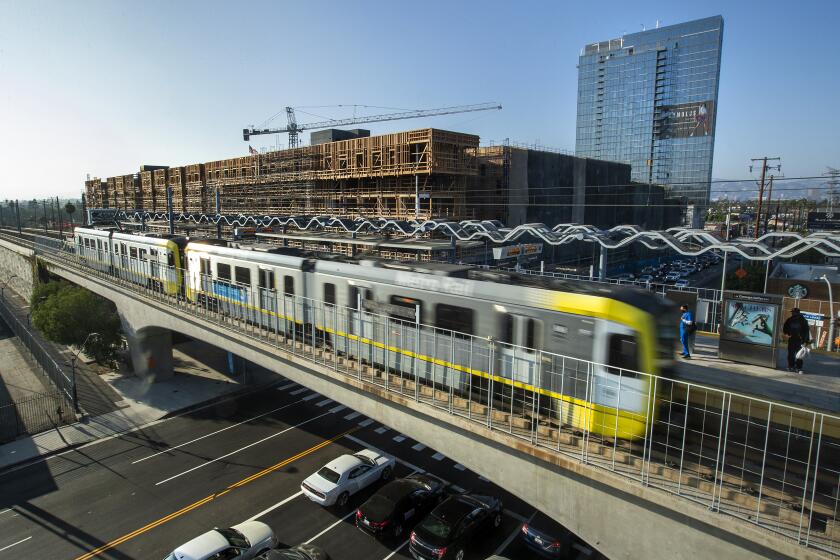After years of cuts, California could provide school buses for all kids

- Share via
SACRAMENTO — The yellow school bus has become an increasingly rare sight in California. But new legislation is aiming to change that, a policy shift that proponents say could curb absenteeism and narrow inequities.
Unlike some other states, California law does not require school districts to provide buses even if a student lives far from campus.
Some students with disabilities or those experiencing homelessness are guaranteed free transportation under federal law, but what a district provides is otherwise up to local school boards.
The state provides limited funding dedicated to public school transportation, and that funding has barely changed since the early 1980s despite an increase in demand. To fill in the gaps, some districts charge parents annual bus fees or encourage students to take the city bus. Others have cut their fleet of school buses altogether.
“Getting to and from school should never be a barrier to student success. The research is clear: Students with school-provided transportation miss far fewer days and are more likely to graduate,” said state Sen. Nancy Skinner (D-Berkeley), who is proposing that the state require school buses for all.
Skinner’s new bill would provide state funding for daily transportation for all of California’s 6 million K-12 students starting next year, alleviating the financial burden for districts.
The bill “will ensure that not having a ride is never again the reason for a child to miss school,” Skinner said in a statement.
Less than 9% of California’s students ride a school bus, the lowest rate of any other state, according to a survey by the Federal Highway Administration in 2017.
Most of California’s students get a private ride to school each day — about 68% — and 18% walk, according to the survey, as the state is home to many urban centers located in close proximity to campuses. But for students who do not have access to a car or whose parents’ work schedules cannot accommodate daily drop-offs and pickups, options are limited.
Even students who live within walking distance of school deserve bus access and may not feel safe in their neighborhoods, said Jill Gayaldo, who has worked in California school transportation for 30 years.
“Districts in higher-income areas, they have parents that drive. Others don’t,” said Gayaldo, who is now a Rocklin City Council member. “You could have the absolute best program in the world, but if kids can’t get to school, it doesn’t do them any good.”
At Sacramento County’s San Juan Unified School District, where nearly half of the students qualify for free or reduced-price meals, school buses are not offered, except for the federally protected subgroups. In 2011, the school board voted to eliminate its general school bus program, citing post-recession financial woes.
Last year, 15% of students were marked “chronically absent” in the district, higher than the state average. For Black students at San Juan Unified, the rate is 35%.
California’s Black and Native American students are most likely to be “chronically absent” and least likely to have access to a vehicle.
The two groups have a “chronically absent” rate of about 27%, compared with the statewide average of 14%, according to the California Department of Education. The chronic absenteeism rate for socioeconomically disadvantaged students is 19%.
While 7% of California households do not own a vehicle, the rate is 15% for Black households and 11% for Native American households, according to the National Equity Atlas.
The state does not track specific reasons for student absences but attendance workers tasked with reaching out to students who aren’t at school report lack of transportation as a top factor.
Skinner’s bill would allow districts to launch state-funded yellow bus programs or partner with public transit agencies to guarantee daily rides to class. Districts would no longer be allowed to charge families a fee for transportation to school.
At Rocklin Unified in Placer County, most students are charged $350 each year to ride the school bus. But that’s still not enough to cover the costs to the district, said spokesperson Sundeep Dosanjh.
“California school districts receive minimal reimbursement of total transportation costs,” Dosanjh said. “The California state funding formula is outdated and provides inequalities throughout the state and leaves most school districts using funds allocated from the general fund.”
A report by the independent Legislative Analyst’s Office in 2014 called the state’s school transportation funding system “problematic,” “irrational” and “outdated.” The LAO review recommended that California change its school transportation funding formula, but it remains the same.
Gov. Jerry Brown vetoed a bill in 2017 that would’ve added a cost of living adjustment to the state’s school transportation fund, projected to cost in the low millions of dollars annually.
Skinner’s team said the projected cost of her more expansive plan is still unknown. A new school bus can cost more than $200,000.
Brown said in his 2017 veto message that while he recognizes the importance of providing student transportation “and the increasing call on local resources for competing priorities,” the state’s education funding formula provides districts with “substantial flexibility and autonomy” to make their own budget decisions.
But even as California schools see record-high funding from the state, some districts choose to put the money toward other classroom needs rather than transportation.
Los Angeles Unified, the second-largest district in the nation, does not provide a daily bus service for the general student body. Last year, the district launched a $2.8-million pilot program that provides free Metro bus and train rides to students. A spokesperson said this week that about 40,000 of the district’s nearly 600,000 students have so far activated Metro passes under the program.
L.A. community college and K-12 students in participating districts can ride Metro trains and buses for free under a new program starting this month.
More than 120,000 students, or about 2% of California’s student body, take a city bus or other public transit to get to class, according to the Federal Highway Administration survey.
In addition, Skinner said the bill will also help fight against climate change by getting millions of cars off the road.
In his state budget proposal, Gov. Gavin Newsom proposed $1.5 billion for green school bus fleets, prioritizing grants for rural districts and those with high concentrations of low-income students, English learners and students in foster care.
Martin Ward, CEO of the Mid-Placer Public Schools Transportation Agency, said for some of his students, it takes nearly two hours to get to school. The districts he serves require payment from parents to offset transportation costs.
“Some districts are wondering whether to provide any transportation at all, and there are kids that are probably compromised because of that,” he said.
Ward said he welcomes a universal state-funded bus plan but warns the state will have to help districts pull it off, especially amid a bus driver shortage compounded by the pandemic. His agency is currently unable to staff three bus routes because of the labor shortage.
“We start at $19 an hour,” he said. “The Chick-fil-A down the street starts at $18.”
More to Read
Sign up for Essential California
The most important California stories and recommendations in your inbox every morning.
You may occasionally receive promotional content from the Los Angeles Times.












